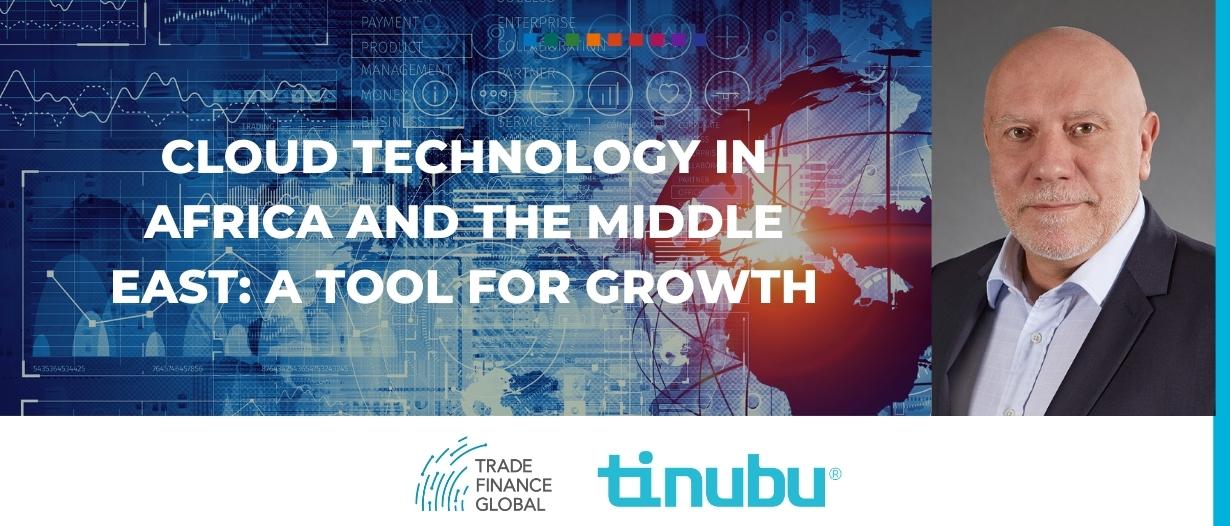What are the driving forces behind the expansion of cloud technology across Africa and the Middle East? How does this impact credit insurance, and what are the opportunities?
Governments and businesses across the Middle East and Africa (MEA) are digitising at a rapid pace, shifting away from on-premises hardware and manual processes in favour of software as a service (SaaS).
In 2022 alone, end-user spending on public cloud services is predicted to grow by 19% to $5.7 billion.
The impact of this large-scale automation and digitisation is becoming clear, with benefits such as speed, scale, and security.
The result: a dramatic, positive impact on economic activity, laying the foundation for long-term scalable growth.
In this article, we look at the triggers, barriers, and rewards that cloud is bringing to economies across the MEA region, and the transformative change it will bring to credit insurance.

The catalyst for change in Africa
While digital advancement was already a high priority for many countries across Africa, the COVID-19 pandemic saw it grow dramatically, with a sudden need for people and businesses to transact and communicate digitally.
Africa’s 1.3 billion population experienced an unprecedented level of digital adoption.
With the world’s 10 youngest populations all located in Africa, it comes as no surprise that the digital native majority drove this at a faster rate than in many other regions.
Thanks also to significant investment in infrastructure across Africa, slow internet speed, and connectivity issues are becoming things of the past.
For developing nations, a younger demographic offers the advantage of a growing working-age population, providing a major opportunity for economic advancement.
To harness this, African nations must find ways to nurture and drive economic activity, create jobs, and build self-sufficient populations.
With the World Economic Forum citing low productivity as a major barrier to economic development in Africa, innovation is critical.
Sub-Saharan Africa is home to 44 million micro, small, and medium enterprises (MSMEs), almost all of which are micro-businesses and serve as the main form of employment.
However, many have no financial means to grow and develop.
If African governments can support them, they will see them grow from micro to small, small to medium and so on, strengthening their economies as a result.
In many ways, domestic credit insurance offers a solution, but current models are designed only to fund major projects.
To give support to large numbers of MSMEs, governments in Africa are looking at innovative credit insurance solutions that can scale rapidly to grow with their economies, and they see SaaS as a key enabler.
Across Africa, credit insurance remains a political matter and requires strong decisions at the top level of the government.
On the western coast of Africa, choosing a SaaS solution is not an obstacle, but inner slowness in the administration can delay decisions.
South Africa has already adopted a SaaS solution for credit insurance, with other countries following suit.
In Kenya, where credit insurance has a long-established presence, the Minister for Commerce is pushing hard to meet the need for guarantees for MSMEs.
This is driving initiatives directly to a SaaS-based short-term credit insurance solution.
Despite rating among the 21 poorest countries in the world, Ethiopia shows a lot of promise, with the Minister for Digitalisation now at the epicentre of a new cloud revolution.
Having been delayed by two years of civil war, the country is now rapidly heading towards extensive cloud adoption.

Driving diversification in the Middle East
Middle Eastern nations are increasingly seeing the benefits of digital transformation.
In a move to shift away from oil-driven to data-driven economies, digitisation offers the chance to grow in other areas.
Thanks to significant investment in infrastructure, the Middle East is now home to some of the world’s leaders in digital transformation, such as the UAE where smart technologies like AI are emerging across all levels of government.
In Saudi Arabia, there is no longer a fear of having local economic data on foreign software or a requirement for an on-premise only solution, thanks to the reality that some businesses must be cloud-based to function at all.
With growing diversity in the industry, data and digital capability are critical levers for supporting activity.
Cloud solutions offer the flexibility to service a broader business community, including SMEs who are emerging as a growing part of the economy.
Several governments in the Middle East have already transformed their credit insurance operations to service broader business needs, including innovative solutions to help local SMEs compete in a global marketplace.
By using SaaS solutions to service this segment, they can offer fast, efficient credit insurance at a low operating cost.
The UAE introduced SaaS into their credit insurance operations over four years ago, and their focus on a paperless economy continues to gain momentum.
Local hosting in MEA
SaaS adoption across the region continues to increase at a rapid pace.
With Amazon Web Services (AWS) establishing local availability zones in Bahrain in 2019 and South Africa in 2020, it is a positive sign that they recognise Africa and the Middle East as prominent cloud consumers and key global players.
Capitalising on the increasing popularity of cloud computing, AWS announced further expansion in 2022, with three additional availability zones in the United Arab Emirates, and local zones in Kenya.
This continued expansion is a clear demonstration of a firm commitment to local capability.
Many in the region had previously avoided cloud adoption due to local data storage concerns.
Data localisation now gives the region reassurance of control over security, compliance, and data protection.
Removing barriers
Cloud acceptance varies across the MEA region, however, we are now seeing the scepticism and perceived risks that were once preventative barriers start to be replaced with optimism and action.
In MEA, the protection of data is critical.
For many, the concept of handing over control of data and no longer having physical, on-premise infrastructure has been a major hurdle.
Legacy systems that have been in place not only in credit insurance but across all industries, are creating stumbling blocks for much-needed diversification.
Contrary to popular belief, the reality is that cloud systems are more secure, and the peace of mind that traditionally comes from on-premise data management poses a far greater risk.
Firstly, with a SaaS solution, there is no longer the physical risk of managing your own data.
Organisations don’t need to develop and implement their own contingency plans for physical data theft or privacy breaches.
Cloud software removes the time and effort required by individual organisations to realise and act on any breaches.
With cloud, continuous monitoring means that any breach is rapidly managed and mitigated.
Cloud service providers have teams of experts that manage data security with the latest solutions and are up to date with current threats, which is not often the case with in-house IT.
Many countries in the region are also concerned with the question of data ownership.
With cloud, they benefit from transferring the traditional risks of data management, without handing over the ownership of the data itself.
For credit insurers, better management of data enables more accurate, smarter decisions and the opportunity to make them at scale.
Plus, the advantage of continuous availability means that services can be delivered without delays to the customer.
For the MEA region, this brings a major opportunity for progressive, economic growth.
Thanks to cloud software, credit insurers can now expand their operations rapidly to meet a growing need for diversification.
With the capacity to expand, not only can they more effectively service traditional customers, but they can now support growing populations of micro, small, and medium-sized businesses, and drive sustainable development.

Financial benefits
While the initial outlay of transforming to a SaaS solution may seem high, this one-off cost is outweighed by both immediate and long-term financial benefits.
Plus, the implementation stage is fast, with operations often ready to use on the same day as installation.
For organisations that are used to dealing with the fall-out of long-term transformation, this is a game-changer.
The cost of hardware and the ongoing upgrades associated with it are now not an issue, so organisations can grow in a much more agile way and respond quickly to market changes.
Continuous improvement is managed by the software provider, who is constantly investing in and upgrading the technology, so their customers don’t have to.
With a much lower total cost of ownership, more focus can be put on whole-of-organisation innovation and transformation.
Similarly, there is no longer the need to employ or maintain a large in-house IT team, as it is all managed by the SaaS provider.
For countries in Africa especially, a lack of adequate skill sets to manage data and hardware in-house is no longer an issue.
Knowledge sharing
Traditionally, establishing credit insurance operations requires in-depth specialist knowledge of local and international risks, with little opportunity for sharing knowledge across the sector.
With SaaS, you become part of a community of users, allowing you to exchange information and knowledge among peers, and suggest enhancements to the software provider.
In countries where this expertise does not already exist, SaaS makes a lot of sense.
The need to employ and retain a team of subject matter experts is reduced, as real-time data and information are provided by the software.
Building momentum
For countries in Africa and the Middle East, there is an urgent need to harness potential and build robust economies.
It is clear that credit insurance transformation plays a key supporting role, with growing recognition that SaaS is the way forward.
Future models must meet the needs of a diverse population and business community, with scalability and lower-cost operating models.
With many governments in the Middle East and Africa abandoning legacy systems in favour of cloud software, the region is now home to some of the most innovative and diverse credit insurance offerings in the world.























